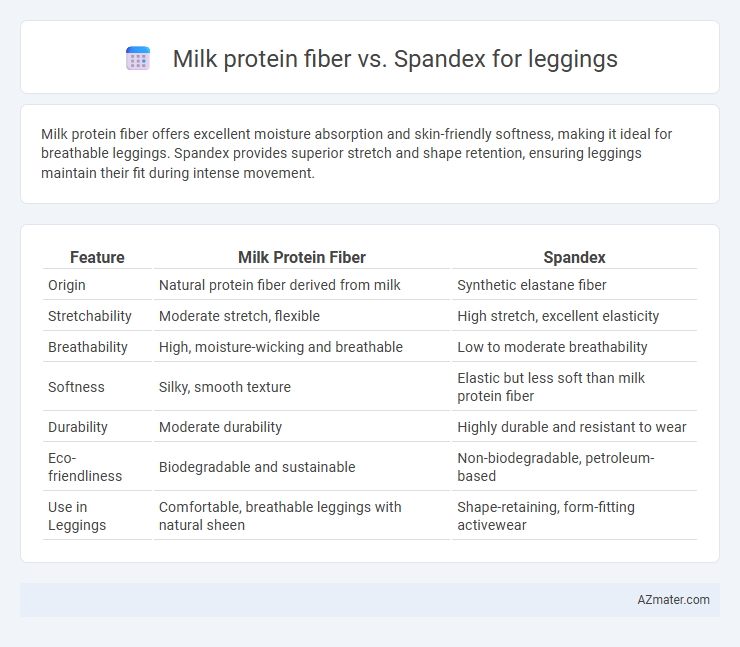Milk protein fiber offers excellent moisture absorption and skin-friendly softness, making it ideal for breathable leggings. Spandex provides superior stretch and shape retention, ensuring leggings maintain their fit during intense movement.
Table of Comparison
| Feature | Milk Protein Fiber | Spandex |
|---|---|---|
| Origin | Natural protein fiber derived from milk | Synthetic elastane fiber |
| Stretchability | Moderate stretch, flexible | High stretch, excellent elasticity |
| Breathability | High, moisture-wicking and breathable | Low to moderate breathability |
| Softness | Silky, smooth texture | Elastic but less soft than milk protein fiber |
| Durability | Moderate durability | Highly durable and resistant to wear |
| Eco-friendliness | Biodegradable and sustainable | Non-biodegradable, petroleum-based |
| Use in Leggings | Comfortable, breathable leggings with natural sheen | Shape-retaining, form-fitting activewear |
Introduction to Milk Protein Fiber and Spandex
Milk protein fiber, derived from casein protein extracted from milk, offers natural moisture absorption, breathability, and softness, making it ideal for comfortable legging fabrics. Spandex, a synthetic fiber known for its exceptional elasticity, provides superior stretch and shape retention, commonly used in performance and activewear leggings. Combining milk protein fiber with spandex blends enhances durability and wearability while maintaining comfort and flexibility in leggings.
Origin and Production Process
Milk protein fiber is derived from casein protein found in milk through a unique biochemical process that involves dissolving milk protein, spinning it into fiber, and solidifying it via drying, resulting in a soft, breathable fabric with natural moisture absorption. Spandex, also known as elastane, is synthesized from petrochemicals through a complex polymerization reaction producing a highly elastic fiber prized for its exceptional stretch and recovery properties in leggings. The origin of milk protein fiber emphasizes sustainability and biodegradability from animal-based proteins, whereas spandex relies on synthetic chemistry and fossil fuel extraction, influencing both environmental impact and performance characteristics.
Composition and Structure
Milk protein fiber, derived from casein protein in milk, features a natural amino acid structure that enhances moisture absorption and skin-friendly softness, unlike synthetic spandex which is a polyurethane-based elastane known for its superior stretch and recovery properties. The unique protein composition in milk fiber offers breathable, hypoallergenic qualities, while spandex's tightly coiled molecular structure provides exceptional elasticity and shape retention in leggings. Combining milk protein fiber with spandex in legging fabric results in a blend that balances comfort, durability, and flexible fit, optimizing performance and user experience.
Comfort and Softness
Milk protein fiber leggings provide exceptional softness due to their natural amino acid composition, which mimics human skin proteins, offering a smooth and breathable fabric ideal for sensitive skin. Spandex leggings excel in stretchability and shape retention, enhancing comfort during movement but often lack the same level of softness and moisture-wicking properties found in milk protein fibers. Choosing milk protein fiber leggings results in a luxuriously soft feel and natural comfort, while spandex leggings prioritize elasticity and fit.
Moisture-Wicking and Breathability
Milk protein fiber leggings offer superior moisture-wicking by efficiently drawing sweat away from the skin, promoting faster evaporation and keeping the wearer dry during intense workouts. This fiber also provides excellent breathability due to its natural porous structure, enhancing airflow and temperature regulation. In contrast, spandex leggings excel in stretch and fit but often lack the same level of moisture management and breathability, making milk protein fiber a preferable choice for activewear focused on comfort and performance.
Elasticity and Stretchability
Milk protein fiber offers moderate elasticity and excellent moisture-wicking properties, making leggings comfortable and breathable but slightly less stretchable compared to spandex. Spandex provides superior elasticity and stretchability, allowing leggings to retain their shape and offer greater freedom of movement during dynamic activities. Combining milk protein fiber with spandex creates leggings with enhanced stretch, durability, and skin-friendly softness.
Durability and Longevity
Milk protein fiber exhibits excellent durability due to its strong molecular structure, offering resistance to wear and tear during frequent use. Spandex provides superior elasticity but tends to lose its shape and strength over time, reducing longevity with repeated stretching. For leggings, milk protein fiber ensures longer-lasting fabric integrity while spandex enhances flexibility but may compromise durability in the long term.
Sustainability and Eco-Friendliness
Milk protein fiber, derived from renewable and biodegradable sources, offers a sustainable alternative to Spandex in leggings, as it reduces reliance on petroleum-based materials. Unlike Spandex, which is non-biodegradable and contributes to microplastic pollution, milk protein fiber decomposes naturally, minimizing environmental impact. This eco-friendly fiber enhances moisture absorption and comfort while supporting a circular textile economy through responsible sourcing and recycling initiatives.
Skin Sensitivity and Allergies
Milk protein fiber leggings offer a hypoallergenic and skin-friendly alternative ideal for sensitive skin, as they are naturally antimicrobial and moisture-wicking, reducing irritation and allergic reactions. Spandex leggings, while highly elastic and durable, may cause discomfort or sensitivity due to synthetic compounds and potential chemical residues like formaldehyde. For individuals prone to skin allergies, milk protein fiber provides a gentler, breathable fabric choice that minimizes redness, itching, and inflammation compared to spandex.
Price Comparison and Market Availability
Milk protein fiber leggings generally cost more than spandex leggings due to the innovative and sustainable nature of milk protein fabric, which commands a premium price in the market. Spandex leggings are widely available with competitive pricing driven by mass production and extensive supplier networks, making them more accessible to a broader consumer base. Market availability of milk protein fiber leggings remains limited to niche and eco-friendly brands, whereas spandex leggings dominate mainstream sportswear and fashion retailers globally.

Infographic: Milk protein fiber vs Spandex for Legging
 azmater.com
azmater.com